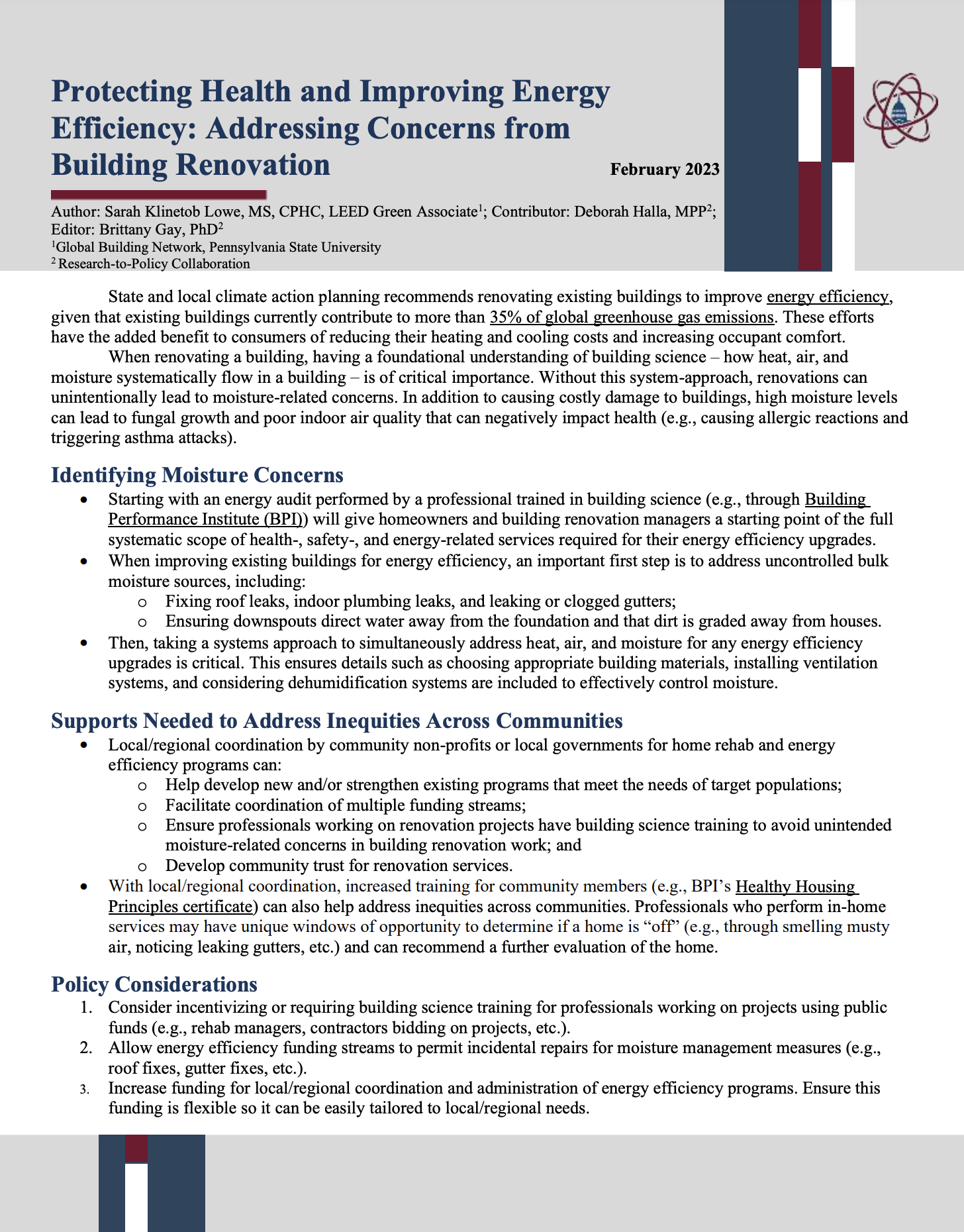
State and local climate action planning recommends renovating existing buildings to improve energy efficiency, given that existing buildings currently contribute to more than 35% of global greenhouse gas emissions. These efforts have the added benefit to consumers of reducing their heating and cooling costs and increasing occupant comfort.
When renovating a building, having a foundational understanding of building science – how heat, air, and moisture systematically flow in a building – is of critical importance. Without this system-approach, renovations can unintentionally lead to moisture-related concerns. In addition to causing costly damage to buildings, high moisture levels can lead to fungal growth and poor indoor air quality that can negatively impact health (e.g., causing allergic reactions and triggering asthma attacks).
Check out this short video – “Grandma’s House” – from the US Department of Energy that walks through how a fragmented approach to renovations can unintentionally lead to moisture problems.
Identifying Moisture Concerns
- Starting with an energy audit performed by a professional trained in building science (e.g., through Building Performance Institute (BPI)) will give homeowners and building renovation managers a starting point of the full systematic scope of health-, safety-, and energy-related services required for their energy efficiency upgrades.
- When improving existing buildings for energy efficiency, an important first step is to address uncontrolled bulk moisture sources, including:
- Fixing roof leaks, indoor plumbing leaks, and leaking or clogged gutters;
- Ensuring downspouts are directing water away from the foundation and that dirt is graded away from houses.
- Then, taking a systems approach to simultaneously address heat, air, and moisture for any energy efficiency upgrades is critical. This ensures details such as choosing appropriate building materials, installing ventilation systems, and considering dehumidification systems are included to effectively control moisture.
Supports Needed To Address Inequities Across Communities
- Local/regional coordination by community non-profits or local governments for home rehab and energy efficiency programs can:
- Help develop new and/or strengthen existing programs that meet the needs of target populations;
- Facilitate coordination of multiple funding streams;
- Ensure professionals working on renovation projects have building science training to avoid unintended moisture-related concerns in building renovation work; and
- Develop community trust for renovation services.
- With local/regional coordination, increased training for community members (e.g., BPI’s Healthy Housing Principles certificate) can also help address inequities across communities. Professionals who perform in-home services may have unique windows of opportunity to determine if a home is “off” (e.g., through smelling musty air, noticing leaking gutters, etc.) and can recommend a further evaluation of the home.
Policy Considerations
- Consider incentivizing or requiring building science training for professionals working on projects using public funds (e.g., rehab managers, contractors bidding on projects, etc.).
- Allow energy efficiency funding streams to permit incidental repairs for moisture management measures (e.g., allow roof fixes, gutter fixes, etc.).
- Increase funding for local/regional coordination and administration of energy efficiency programs. Ensure this funding is flexible so it can be easily tailored to local/regional needs.
The Research-to-Policy Collaboration (RPC) works to bring together research professionals and public officials to support evidence-based policy. Please visit their website to learn more.
Key Information
RPC Website
Research-to-Policy Collaboration
More RPC Resources
RPC Resources
Publication DateFebruary 1, 2023
Topic Area(s)Environment and Earth Sciences
Resource TypeWritten Briefs
Share This Page
State and local climate action planning recommends renovating existing buildings to improve energy efficiency, given that existing buildings currently contribute to more than 35% of global greenhouse gas emissions. These efforts have the added benefit to consumers of reducing their heating and cooling costs and increasing occupant comfort.
When renovating a building, having a foundational understanding of building science – how heat, air, and moisture systematically flow in a building – is of critical importance. Without this system-approach, renovations can unintentionally lead to moisture-related concerns. In addition to causing costly damage to buildings, high moisture levels can lead to fungal growth and poor indoor air quality that can negatively impact health (e.g., causing allergic reactions and triggering asthma attacks).
Check out this short video – “Grandma’s House” – from the US Department of Energy that walks through how a fragmented approach to renovations can unintentionally lead to moisture problems.
Identifying Moisture Concerns
- Starting with an energy audit performed by a professional trained in building science (e.g., through Building Performance Institute (BPI)) will give homeowners and building renovation managers a starting point of the full systematic scope of health-, safety-, and energy-related services required for their energy efficiency upgrades.
- When improving existing buildings for energy efficiency, an important first step is to address uncontrolled bulk moisture sources, including:
- Fixing roof leaks, indoor plumbing leaks, and leaking or clogged gutters;
- Ensuring downspouts are directing water away from the foundation and that dirt is graded away from houses.
- Then, taking a systems approach to simultaneously address heat, air, and moisture for any energy efficiency upgrades is critical. This ensures details such as choosing appropriate building materials, installing ventilation systems, and considering dehumidification systems are included to effectively control moisture.
Supports Needed To Address Inequities Across Communities
- Local/regional coordination by community non-profits or local governments for home rehab and energy efficiency programs can:
- Help develop new and/or strengthen existing programs that meet the needs of target populations;
- Facilitate coordination of multiple funding streams;
- Ensure professionals working on renovation projects have building science training to avoid unintended moisture-related concerns in building renovation work; and
- Develop community trust for renovation services.
- With local/regional coordination, increased training for community members (e.g., BPI’s Healthy Housing Principles certificate) can also help address inequities across communities. Professionals who perform in-home services may have unique windows of opportunity to determine if a home is “off” (e.g., through smelling musty air, noticing leaking gutters, etc.) and can recommend a further evaluation of the home.
Policy Considerations
- Consider incentivizing or requiring building science training for professionals working on projects using public funds (e.g., rehab managers, contractors bidding on projects, etc.).
- Allow energy efficiency funding streams to permit incidental repairs for moisture management measures (e.g., allow roof fixes, gutter fixes, etc.).
- Increase funding for local/regional coordination and administration of energy efficiency programs. Ensure this funding is flexible so it can be easily tailored to local/regional needs.
The Research-to-Policy Collaboration (RPC) works to bring together research professionals and public officials to support evidence-based policy. Please visit their website to learn more.

Key Information
RPC Website
Research-to-Policy Collaboration
More RPC Resources
RPC Resources
Publication DateFebruary 1, 2023
Topic Area(s)Environment and Earth Sciences
Resource TypeWritten Briefs
Share This Page
LET’S STAY IN TOUCH
Join the Evidence-to-Impact Mailing List
Keep up to date with the latest resources, events, and news from the EIC.




